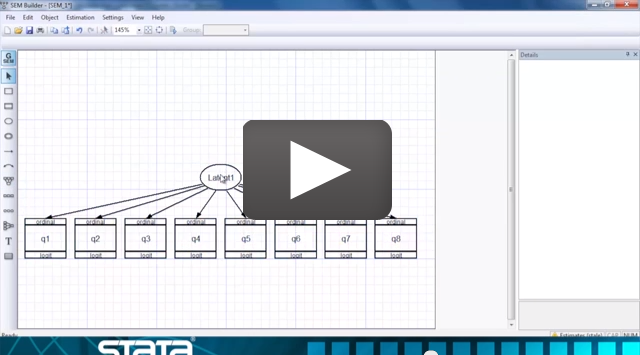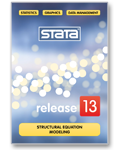
Generalized SEM | ORDER STATA |

In Stata 12, we introduced linear SEM.
In Stata 13, we introduce generalized SEM, by which we mean (1) SEM with generalized linear response variables and (2) SEM with multilevel mixed effects, whether linear or generalized linear.
Generalized linear response variables mean you can now fit logistic, probit, Poisson, multinomial logistic, ordered logit, ordered probit, and other models. It also means measurements can be continuous, binary, count, categorical, and ordered.
Multilevel mixed effects means you can place latent variables at different levels of the data. You can fit models with fixed or random intercepts and fixed or random slopes.
Say we have a test designed to assess mathematical performance. The data record a set of binary variables measuring whether individual answers were correct. The test was administered to students at various schools.
We postulate that performance on the questions is determined by unobserved (latent) mathematical aptitude and by school quality, representing unmeasured characteristics of the school:
In the diagram, the values of the latent variable SchQual are constant within school and vary across schools.
We can fit the model from the path diagram by pressing  . Results will appear on the diagram.
. Results will appear on the diagram.
Or, we can skip the diagram and type the equivalent command
. gsem ( MathApt -> q1 q2 q3 q4)
(SchQual[school] -> q1 q2 q3 q4), logit
Either way, we get the same results:
Generalized structural equation model Number of obs = 2500 Log likelihood = -6506.1646 ( 1) [q1]SchQual[school] = 1 ( 2) [q2]MathApt = 1
| Coef. Std. Err. z P>|z| [95% Conf. Interval] | ||
| q1 <- | ||
| SchQual[school] | 1 (constrained) | |
| MathApt | 1.437913 .1824425 7.88 0.000 1.080333 1.795494 | |
| _cons | .0459474 .1074647 0.43 0.669 -.1646795 .2565743 | |
| q2 <- | ||
| SchQual[school] | .1522361 .0823577 1.85 0.065 -.0091821 .3136543 | |
| MathApt | 1 (constrained) | |
| _cons | -.377969 .0518194 -7.29 0.000 -.4795332 -.2764047 | |
| q3 <- | ||
| SchQual[school] | .5194866 .0965557 5.38 0.000 .3302408 .7087324 | |
| MathApt | .8650544 .1098663 7.87 0.000 .6497204 1.080388 | |
| _cons | .026989 .0667393 0.40 0.686 -.1038175 .1577955 | |
| q4 <- | ||
| SchQual[school] | .6085149 .119537 5.09 0.000 .3742266 .8428032 | |
| MathApt | 1.721957 .2466729 6.98 0.000 1.238487 2.205427 | |
| _cons | -.3225736 .0845656 -3.81 0.000 -.4883191 -.1568281 | |
| var(SchQual[school]) | .4167718 .1222884 .2344987 .7407238 | |
| var(MathApt) | 1.004914 .1764607 .7122945 1.417744 | |
Math aptitude has a larger variance and loadings than school quality. Thus math aptitude is more important than school, although school is still important.
See the entire 563-page Structural Equation Modeling Manual and especially see the introduction.

We have added 18 new, worked examples demonstrating generalized SEM.
Single-factor measurement model (generalized response)
One-parameter logistic IRT (Rasch) model
Two-parameter logistic IRT model
Two-level measurement model (multilevel, generalized response)
Two-factor measurement model (generalized response)
Full structural equation model (generalized response)
Logistic regression
Combined models (generalized responses)
Ordered probit and ordered logit
MIMIC model (generalized response)
Multinomial logistic regression
Random-intercept and random-slope models (multilevel)
Three-level model (multilevel, generalized response)
Crossed models (multilevel)
Two-level multinomial logistic regression (multilevel)
One- and two-level mediation models (multilevel)
Tobit regression (censored regression)
Interval measurement regression
Heckman selection model
Endogenous treatment-effects model
See New in Stata 18 to learn about what was added in Stata 18.